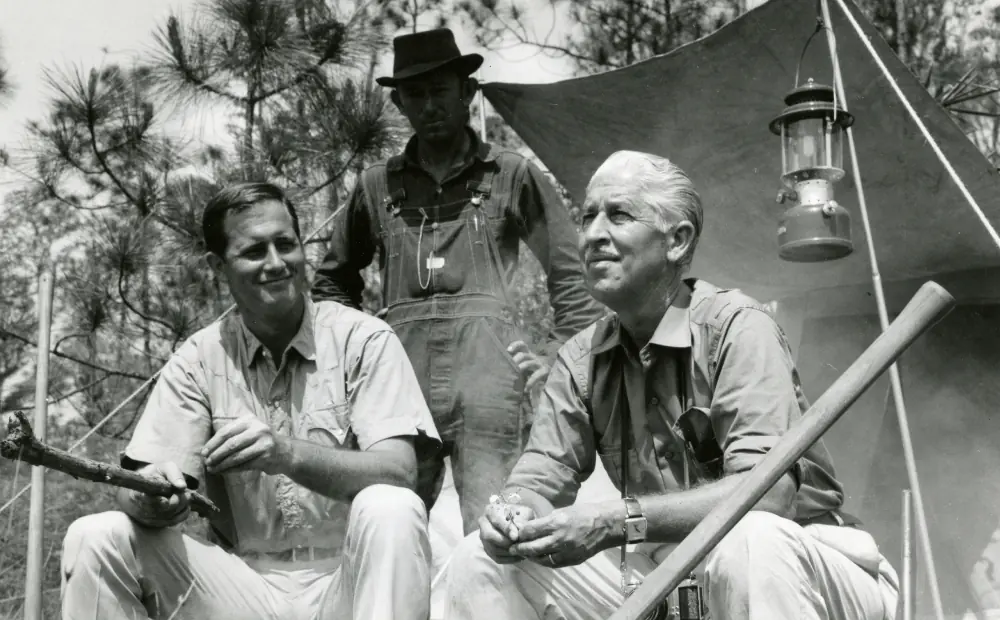0:00
I'm about to do something you're never supposed to do.
0:03
You should never disturb a hibernating bear and never get between a mother bear and her cubs.
0:09
But today, I'm part of an important conservation research project, and we're about to come face to face with wild bears.
0:18
Right now, the biologists here are preparing the sedative that we'll use to tranquilize the mother bear and joining an expert team led by biologists from New Hampshire Fish and Game and by Ben and Ethan Kilham from the Kilham Bear Center.
0:34
I look forward to having you all show me this bear and then more of the bears that you have at your center.
0:40
Ben and Ethan have worked to protect and rescue black bears for years.
0:44
This morning, we're using radio telemetry to guide us to a mother black bear that Ben knows well.
0:50
Scientists have been using radio telemetry to monitor bears for decades.
0:54
As we highlighted on Wild Kingdom over 40 years ago, wildlife biologists have been putting radio telemetry collars on bears in recent years to track them in their habitat.
1:06
The collars send out radio signals that can be picked up by the antenna as far as 5 miles away.
1:13
It is necessary to change the batteries in these collars each year.
1:18
The easiest time to do this is in the winter, when the black bear is in her den, has delivered her cubs, and the new little family is hibernating.
1:31
OK, we got the mother bear anesthetized.
1:35
I can already see a little cub.
1:37
It's like a light kind of a grayish color.
1:40
I I got to get in there.
1:45
Checking on bears in their hibernation dens is something I've done many times in my work as a wildlife ecologist, but I got to say, it never gets old.
1:56
OK, we've got 2, We've got two.
2:01
Hello.
2:01
And we've got we have 3 newborn cubs to this Mama.
2:09
I'm going to pass them off to some of our crew to keep them warm.
2:12
They are too little to thermoregulate right now, which means they cannot produce their own body heat.
2:17
They need their mother's body heat or a volunteer to keep them warm.
2:22
Welcome to motherhood.
2:24
OK, Take care.
2:27
And we're going to open up your jacket.
2:28
Just stuff it in.
2:29
Yeah, this is science, but it's also magical.
2:35
Carefully monitoring black bear families like this one is critical conservation.
2:40
Black bears were nearly wiped out across New England just a few decades ago.
2:45
Now they're making a comeback.
2:48
Right now I'm cuddling this little one who's kind of exploring my scent and my body a little bit, trying to keep it warm for the few minutes, but it'll be away from its mother.
2:59
We will do an exam on each of these three Cubs.
3:03
We'll understand if it's male or female, it's weight, and then put it right back with its mom and see them again in the summer.
3:11
The sow is very stable.
3:13
Her color is great and the anesthetic is working just the way it should and she's tolerating it very well.
3:21
Our goal is to get her back in a natural state as soon as possible.
3:25
We always try to cover the bears eyes during this.
3:28
It reduces stress.
3:30
We have some oxygen in her nose.
3:33
But if I were to just take a quick look at her body condition, her fur, everything, she looks healthy.
3:38
And then the most important part of all this in my opinion is the GPS collar.
3:43
She's collared here and that tracking collar allows us to even find this den in the 1st place.
3:50
Last summer, Ben Kilham collared this bear named Wanda.
3:54
This could not be possible without the Kilham Bear Center.
3:57
You know these bear in the research that we do is in conjunction with them.
4:02
The data collected from this little family will help protect the bear population in this area and the species as a whole.
4:10
They have such incredible paws and these long claws that allow them to climb trees really easily.
4:17
They're incredible tree climbers.
4:19
Never try to escape a bear by climbing a tree.
4:23
Since I've been studying bears for years, I get asked the question of do baby bears smell kind of wild, right?
4:30
Are they dirty because they live here?
4:32
They're born in this wilderness and, you know, kind of like human babies.
4:36
They are very clean.
4:37
They smell clean.
4:39
They don't have much of A scent that actually protects them when they're young and vulnerable from any predators that might try to get them.
4:46
This is honestly cub cuddling in the name of science.












